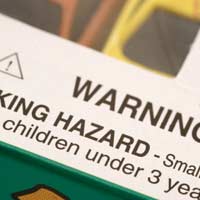The Toy Safety Directive 2011

The main difference in the new European Toy Safety Directive, which in force in July 2011 is that it will widen the definition of what can be considered as a toy, so that from then on, any products which are ‘designed or intended, whether or not exclusively, for use in play by children under 14 years of age’ will be covered by the toy safety regulations.
It will mean that more consumer goods will face more rigid regulation than before, which includes restriction of 19 chemical elements rather than eight which are currently restricted for safety reasons in toys.
As with all new laws, there are some anomalies and grey areas which might need to be addressed. For example, while children’s fashion jewellery isn’t considered a toy by the regulations, fancy dress items and accessories are covered.
The EU Toy Safety Directive simply sets out a list of requirements which all toys have to comply with, and it’s adopted by each individual EU member state and added into their own Toy Safety Regulations. In the UK this is the Toys (Safety) Regulations 1995. This directive will apply to all toys imported into or produced within the EU apart from the sections that apply to chemical requirements – these come into force from 20 July 2013.
Why Has Toy Safety Law Been Amended?
The main reasons for changes in toy safety legislation are due to new scientific evidence which has highlighted potential health risks from some toys and materials used in toy manufacture; the types of toys which are being produced, and the increase in the volume of toys which are being imported from outside the EU.The new toy safety directive is also designed to harmonise the existing EU-wide standards on toy safety. Originally, things like toys’ physical and mechanical properties, their flammability, chemical properties and electrical properties were covered by the legislation, but other just as important safety aspects such as radioactivity and hygiene weren’t governed by safety standards.
The Toy Safety Directive (and any of the Member State regulations which come from it) sets out that the closest applicable national or international standards should be applied to any toy if there is no specific standard for it already set out in the Directive. This clause has been designed to make sure that new and innovative toys will be safe for children to use before they go on sale.
What Happens if EU Toy Safety Regulations are not Met?
If a toy is found to be unsafe (because it breaches one of the standards set out in the legislation, or is generally unsafe because of another unspecified reason, the producer (in law, this is either the manufacturer, or the first importer who brings the toy into the EU) will be guilty of an offence under the Toys (Safety) Regulations (or the equivalent law in the EU member state).In the UK, a producer can argue that all reasonable steps were taken to ensure the toy’s safety by the producer – called due diligence - to avoid being prosecuted, made to pay a fine or even possible imprisonment.
If a toy is discovered to be unsafe, it’s then withdrawn from the market, and all EU member states' authorities are notified through the RAPEX alert system.


Re: Toy Safety Standards in the UK
Selling handmade knitted, crocheted and fabric toys for charity. How do I find out information re the chemical compounds in the…
Re: Toy Safety Standards in the UK
I have bought some small packaging, shipping boxes from Amazon and decorated them with stickers and other eye catching…
Re: Toy Safety Standards in the UK
Hello. Can you tell me if I need a test for a certified safe wooden doll that has been painted with acrylic paint and has a…
Re: Second Hand Toys: What Are my Rights?
Recently sold (reluctantly) a transformer listed on a Facebook transformers selling page for £35, listed price was…
Re: Toy Safety Standards in the UK
Robie szydelkowe misie, laliki, z wlóczki sprzedawanej na rynku( yarnart jeans itp). Co powinnam zrobic aby móc je sprzedawac…
Re: Toy Safety: What Does the Law Say?
idk
Re: Toy Safety Standards in the UK
Hey, I am hoping to sell some wooden stands to go along side some artwork im selling for children 3+ they are meant to be played…
Re: Second Hand Toys: What Are my Rights?
Please advise...I plan to set up a hoopla stall at summer fete can I give second hand soft plushtoys as prizes? I will…
Re: Toy Safety Standards in the UK
Hi i have currently made up some educational busy books which are made up of laminated paper sheets with velcro laminated…
Re: Toy Safety Standards in the UK
Hi, I am thinking of starting a business selling sensory kits for over 3’s. They would contain coloured rice, chickpea, lentils…